World
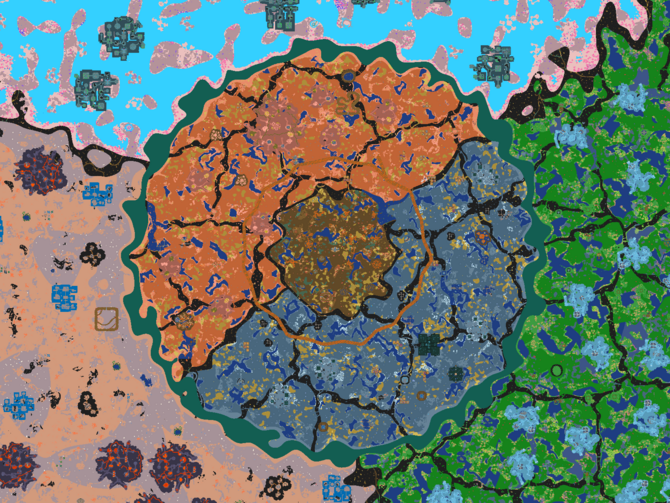
Core Keeper worlds are canonically subterranean environments for players to explore, starting from The Core in the centre. The outer reaches are theoretically infinite, within the top-down two dimensional plane.
Each new world has major attributes set by a hidden randomised seed value, like biome rotation and exact boss spawn locations. Other more minor features, including most scenes, are randomly spawned around players as they explore. While most terrain and objects are procedurally generated.
World file save data is stored separately from player and map files.
Biomes[edit]
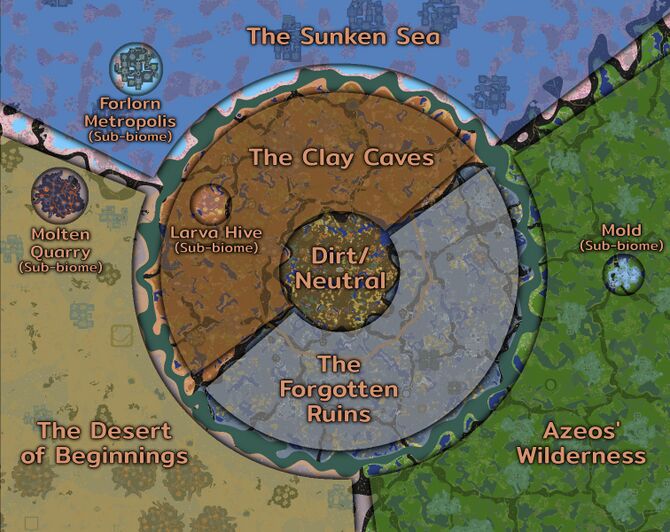
- Main article: Biomes
The biome areas of the world are geometrically defined in segments. Nearby blocks, ground tiles and objects have no influence on determining the local biome type. But terrain generation is configured to roughly correlate with these zones, while creating a wavy looking boundary.
The biome areas are bounded by fixed distance ranges, from the world's centre, and positioned at random rotations determined by the (hidden) world seed.
Inner Biomes[edit]
At the centre of every world is the Dirt Biome. This is internally known as "The Undergrounds". However, it is not named at the top right of the in-game map screen. Its main circle has a radius of 140 tiles. But this is also the default biome in all the gaps between the other biomes.
The Clay Caves and The Forgotten Ruins (AKA the stone biome), fill most of the space from 150 to 450 tiles out. With a 5 degree gap between them. Their angular position is different for each world, as determined by the seed. The Larva Hive Biomes are dungeon structures within The Clay Caves.
The Great Wall is the wavy structure that initially surrounds the three finite inner biomes. The Wall occupies the gap from 450 to 520 tiles and gates access to the outer biomes, in Game Progression.
Outer Biomes[edit]
The infinite outer biomes start at 520 tiles out, with a 5 degree gap between them. They are Azeos' Wilderness, The Sunken Sea and The Desert of Beginnings. Again, at angles randomised upon world creation and in a counter-clockwise order.
The sub-biomes: Mold, Forlorn Metropolis and Molten Quarry are merely dungeon structures within their three respective outer biome areas.
Set distance locations[edit]
Most important locations have their position set at world creation, at a random angle along arcs of specific ranges from The Core. This includes all bosses, optional and part of core game progression.
Many of the points of interest scenes can also be located reliably by searching along arcs, within their associated biome. This includes all the locations needed to assemble Phantom Spark legendary bow (guide), the Soul Seeker legendary pickaxe and the Godsent armor set (guide).
However, some scenes are instead spawned dynamically as the world is generated (see below). These exceptions include the medium maze (for Clear Gemstone) and small temples (for Chipped Blade) needed to craft the Rune Song legendary sword (guide). Also, the Thread of Fate's eye shaped scene.
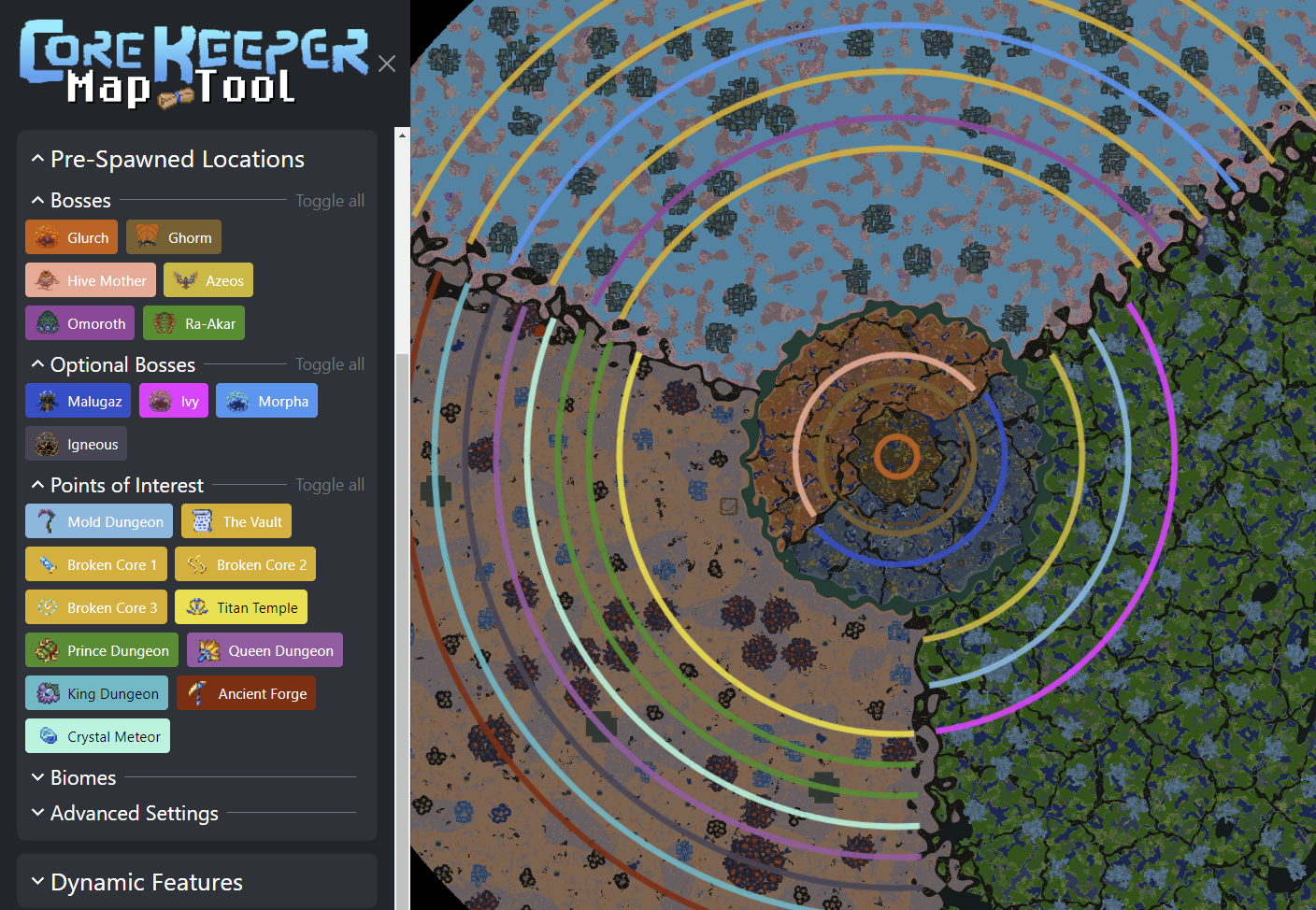
World generation algorithm[edit]
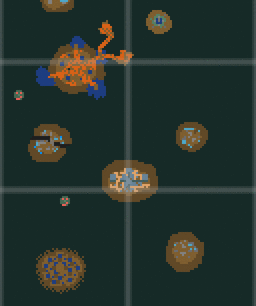
Below is an outline of the order in which the game proceeds through its procedural generation of worlds. This process continues to unfold as players explore, gradually increasing the size of the world save file.
(1) All tiles are Obsidian Walls by default, when contents are undefined.
(2) When the first player enters a world, certain fixed range scenes are spawned: The Core, spawns for the first 3 bosses and the NPC merchants' scenes. This permits these NPCs to be found before obtaining their summoning item, or immediately teleported to a room in a new world.
(3) GPU processes are used to create procedurally generated terrain and randomised scenery objects. This is done in any 64x64 map chunks that contain a single defined tile. Initially, this is any chunks that the above mentioned scenes land in.
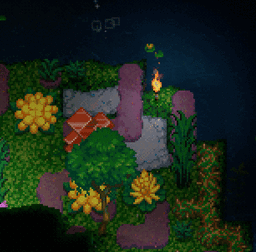
(4) Chunk terrain generation is also triggered by players coming within a range of roughly 30 tiles of an empty chunk's boarder. I.e. over the half-way point of an adjacent chunk.
(5) The world chunk grid has a corner between 4 chunks at the origin point. This is the bottom left corner of the default player spawn location tile, just below The Core statue itself.
(6) The terrain generation pattern of chasms and gorges are created via a Voronoi noise algorithm. Similarly, the undulating terrain boundaries between biomes use a convolution algorithm that is deterministic. Both give natural looking chaotic patterns determined entirely by the world seed. Hence are reproducible when seeding a new dedicated server world.
(7) When a map chunk's terrain is generated, there's a chance to spawn a structure. These are either a biome specific dungeon or one random scene from a weighted list of scenes for that biome area. In the central dirt biome, up to two scenes may spawn per chunk. This structure generation can sometimes cause a domino effect, if new structure is pushed out of the centre of their chunk(s) by proximity to pre-existing structures. The new structure may overlap a chunk border, triggering another chunk to generate terrain and an additional random structure.
(8) Terrain is normally generated simultaneously with pre-made scenes. But if the world is run on a dedicated sever without a GPU, or the server is run using the -nographics launch argument, only the scenes will be generated. They appear stamped down into a sea of solid Obsidian Walls. (These can only be traversed using a no-clip feature in a mod.)

(9) Ghorm's movement lays down tiles in it's wake. This triggers terrain generation in that chunk, and placement of scenes and dungeons around the track, before players go anywhere near. These may possibly include the notable Clear Gemstone containing medium maze scene, for one example.
(10) Boss spawn scenes are only laid down once some terrain is generated within their footprint. Despite having their locations pre-set by the seed at world creation. Points of interest, e.g. the Main Mold Dungeon, also have fixed locations and their dungeon generation is set by the world seed.

Then the world was reloaded in a dedicated server run with the
-nographics command, to prevent further terrain generation. CK Workshop app was used to reveal the existing generation. Map Tool to render this to an image file which was edited to crop out stranded scenes not generated during the initial 4 minutes.Dungeon generation[edit]
Procedurally generated dungeons are large structures comprised of several areas or rooms connected together. They may incorporate some scenes within this network. Dungeons are biome specific and mostly spawned at random, by player exploration, into individual or 2x2 world chunk areas.
The sub-biomes are each a type of dungeon, in terms of world generation: Larva Hive Biome, Mold Biome, Forlorn Metropolis and Molten Quarry. The Caveling cities in The Forgotten Ruins do not represent sub-biomes, but are also dungeons, with no walls and large, overlapping blob areas.
Most bosses are are also associated with a dungeon type, generated around their spawn scene. Most points of interest, too. These dungeons are usually larger than normal, occupying up to approximately 3x3 chunks in size. But they are not aligned to the chunk grid, due to the central scene being located along a fixed distance arc, as shown above.
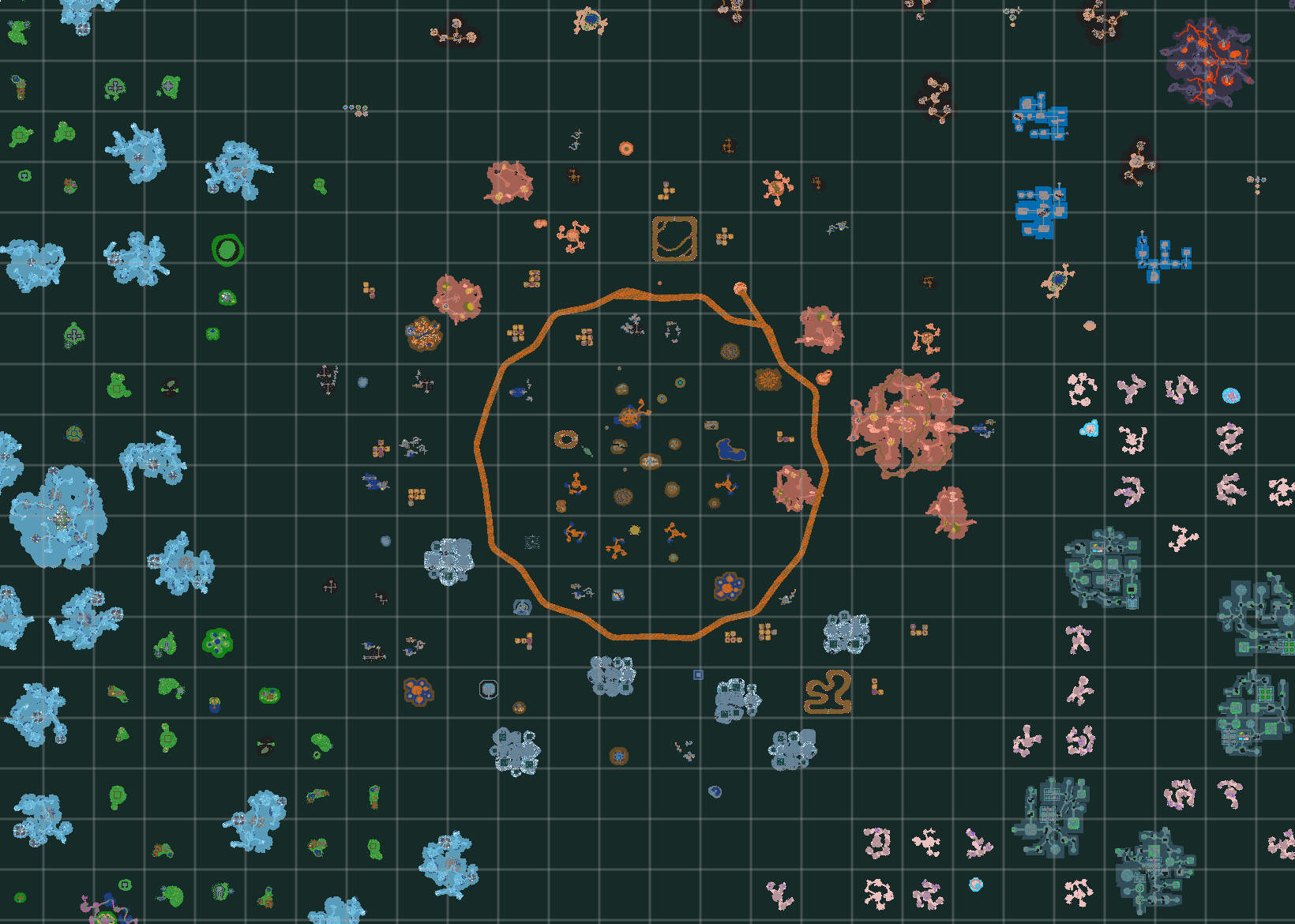
-nographics, fully explored and revealed using CK Workshop app, map image via Map Tool.Dungeon types (list)[edit]
This is an index of the different types of procedurally generated dungeon-type structures. Shown as they appear on a revealed map with terrain generation suppressed. 64x64 world chunk grid shown using Map Tool. Not all dungeon types have official names.
| Map appearance | Dungeon type description | Biome location(s) |
|---|---|---|
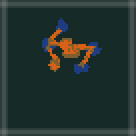
|
Slime | Dirt Biome |
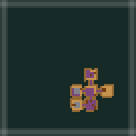
|
House | The Clay Caves The Forgotten Ruins |
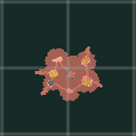
|
Larva Hive Biome (sub-biome) |
The Clay Caves |

|
Clay moss Caveling encampment | The Clay Caves |
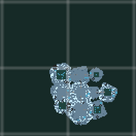
|
Caveling City | The Forgotten Ruins |

|
Mold Biome (sub-biome) |
Azeos' Wilderness |
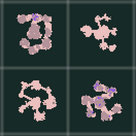
|
Islands (enclosed and open) | The Sunken Sea |
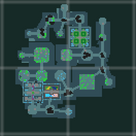
|
Forlorn Metropolis (sub-biome) |
The Sunken Sea |

|
Hidden canyon Caveling village | The Desert of Beginnings |
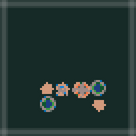
|
Mini temple and maze cluster | The Desert of Beginnings |
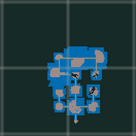
|
Temple | The Desert of Beginnings |
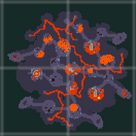
|
Molten Quarry (sub-biome) |
The Desert of Beginnings |
Exploration[edit]
Terrain traversal progression[edit]
Upon first spawning in a new world, with a new character, players explore slowly by break through the soft walls of the Dirt and other inner biomes. Progression is initially made quite quickly, though Crafting tiers for stronger, faster ![]() Pickaxes. Also levelling mining and running skills to speed this up. Wood Bridges crafted and placed easily bridge gaps.
Pickaxes. Also levelling mining and running skills to speed this up. Wood Bridges crafted and placed easily bridge gaps.
After access to Tin Workbench, players can craft Minecarts and ![]() Rails to create a transport network that allows quicker and easier movement, back and forth. This will typically be between a base at The Core and key locations, like boss spawns or any frontier of exploration. This transport mode is most relevant through exploration of the inner biomes and Azeos' Wilderness.
Rails to create a transport network that allows quicker and easier movement, back and forth. This will typically be between a base at The Core and key locations, like boss spawns or any frontier of exploration. This transport mode is most relevant through exploration of the inner biomes and Azeos' Wilderness.
![]() Recall Idols are consumables that teleport the player back to the default spawn location, at The Core, after a short channelling animation. Allowing an easy return to base. However, they are rare to find as loot and initially expensive to craft, at Ghorm's Boss Statue. So should be used sparingly.
Recall Idols are consumables that teleport the player back to the default spawn location, at The Core, after a short channelling animation. Allowing an easy return to base. However, they are rare to find as loot and initially expensive to craft, at Ghorm's Boss Statue. So should be used sparingly.
Scarlet Workbench gives access to ![]() Boats for easy exploration of The Sunken Sea, which is predominantly water.
Boats for easy exploration of The Sunken Sea, which is predominantly water.
![]() Portals are the ultimate long distant transport: interacting with one, that's been placed for at least 20 minutes, opens the map to select any other powered up Portal as an almost immediate destination. These are ideal for quickly returning to locations in the distant outer biomes. However, they expensive crafting recipes, in the Octarine Workbench. So these are only viable to use, all over, well into Sunken Sea exploration, after a significant amount of mining a Ore Boulders and farming the relevant mobs.
Portals are the ultimate long distant transport: interacting with one, that's been placed for at least 20 minutes, opens the map to select any other powered up Portal as an almost immediate destination. These are ideal for quickly returning to locations in the distant outer biomes. However, they expensive crafting recipes, in the Octarine Workbench. So these are only viable to use, all over, well into Sunken Sea exploration, after a significant amount of mining a Ore Boulders and farming the relevant mobs.
The faster ![]() Go-Karts, crafted at the Go-Kart Workbench, can be used to drive the more open areas of The Desert of Beginnings. However, their utility for exploration is arguable, given the difficulty to see obstacles far enough ahead, and inability to attack enemies while driving.
Go-Karts, crafted at the Go-Kart Workbench, can be used to drive the more open areas of The Desert of Beginnings. However, their utility for exploration is arguable, given the difficulty to see obstacles far enough ahead, and inability to attack enemies while driving.
Exploration strategy[edit]
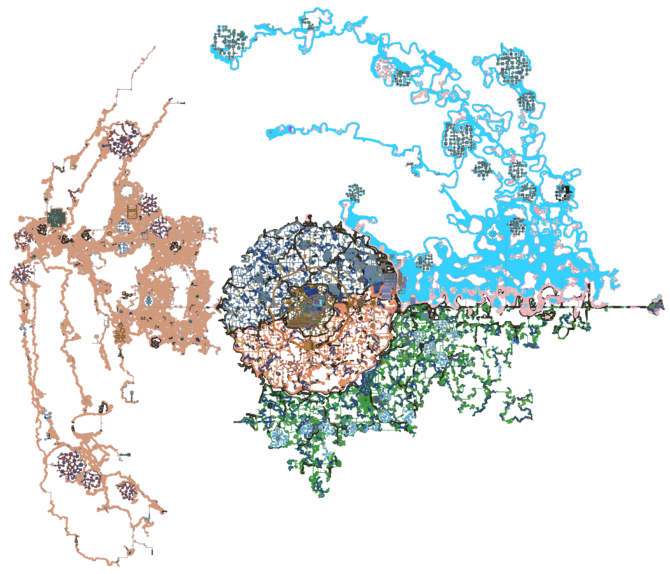
Glurch and Ghorm are almost impossible to miss, when striking out from the centre of the world. However, Hive Mother is further out and, for expedient location, may require the use of a ![]() Hive Mother Scanner, crafted at the Glurch boss statue.
Hive Mother Scanner, crafted at the Glurch boss statue.
Outer biome bosses, core and optional, can all be located with scanners crafted at the ![]() Spirit Merchant, using specific items found in their native biomes. However, players could also navigate the fixed distance arcs shown above. Note: there is currently no scanner for Malugaz' throne room, so distance ring or brute force exploration are the only options.
Spirit Merchant, using specific items found in their native biomes. However, players could also navigate the fixed distance arcs shown above. Note: there is currently no scanner for Malugaz' throne room, so distance ring or brute force exploration are the only options.
Locating the ingredient parts for ![]() Rune Song legendary sword is a common difficulty for players (see full guide). They appear uniquely in a limited number of scenes that are dynamically spawned, following the world generation algorithm described above. So, the medium maze, for example, could appear in The Forgotten Ruins, or randomly failing to appear there, instead end up in Azeos' Wilderness, causing confusion. Then, haphazard exploration, deep into the wilderness, could cause all 3 of the tiny, unilluminated Chipped Blade temples to land off to the side of that distant route.
Rune Song legendary sword is a common difficulty for players (see full guide). They appear uniquely in a limited number of scenes that are dynamically spawned, following the world generation algorithm described above. So, the medium maze, for example, could appear in The Forgotten Ruins, or randomly failing to appear there, instead end up in Azeos' Wilderness, causing confusion. Then, haphazard exploration, deep into the wilderness, could cause all 3 of the tiny, unilluminated Chipped Blade temples to land off to the side of that distant route.
To most efficiently locate all of the dynamically spawned unique scenes, when initially entering each outer biome, it is best to create an expanding area of mapped terrain. Always travelling around the entire perimeter of what has previously been explored, such that no dark gaps are left where scenes might have appeared. So, either and outward spiral, or a back and forth route pushing out from across the entire inner edge. Only striking out to bosses and other known locations, afterwards. Or, at least knowing to search around the path travelled to them, later on. This applies to finding the small Desert scene containing the Thread of Fate, for crafting the Oracle Deck.
The points of interest needed for the ![]() Phantom Spark legendary bow are all found at fixed radii, so this quest is logically simpler (full guide). So too the
Phantom Spark legendary bow are all found at fixed radii, so this quest is logically simpler (full guide). So too the ![]() Soul Seeker legendary pickaxe and Godsent armour set.
Soul Seeker legendary pickaxe and Godsent armour set.
